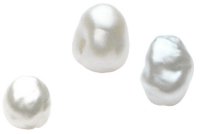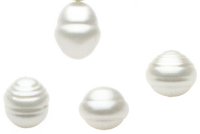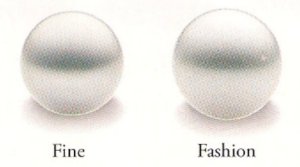 FREE SHIPPING on US orders over $150. Need help? Contact Us
FREE SHIPPING on US orders over $150. Need help? Contact Us Selecting a South Sea Cultured Pearl
Pearl strands and loose pearls are graded according to the five Virtues. The five Virtues of South Sea cultured pearls are:
Natural Luster • Shape • Size • Natural Color • Complexion
Natural Luster
Luster is the single most important determinant of pearl quality. Luster is derived from the pearl’s countless layers of pearl nacre - nacre is the natural pearly substance that forms the body of the pearl itself. It is the nacre of a pearl that causes light to be refracted from different depths of the nacreous layers through minute prisms, giving each pearl its unique lustrous appearance.
The pearls available from Stellar Jewelry by Paspaley are all of excellent luster due to the quality and thickness of the nacre. Importantly, the luster of these pearls is untreated and as such their beauty will not diminish over time if cared for properly.
Shape
From Round to Drop, Button to Baroque, pearls come in an almost infinite variety of shapes. A pearl’s shade does not affect its quality. However, the popularity of particular shapes – or the rarity of others –can result in a premium on the price of some shapes.
Classic Shapes
Round • Near Round • Oval • Drop • Full Button

Round Pearls • Round pearls are symbolic of the perfection that can be achieved by Mother Nature. Although it is very difficult to perfectly match and assemble any strand of South Sea pearls, the difficulty is even greater with high quality round pearls due to their comparative rarity. The rarity and timeless elegance of high quality round South Sea pearl strands make them the most valuable and highly sought after of pearl strands. Round pearls are ideal for use in strands or as matched pairs.
Near Round (aka Semi-Round) Pearls • Near Round pearls are slightly off round in shape but appear almost perfectly round once drilled and strung into strands. The resulting beauty of these strands makes them a slightly less expensive alternative to round strands.
Oval Pearls • Oval pearls are a beautiful alternative to the traditional round or semi-round pearls. Many women prefer them as they feel they are softer and that the slightly longer shape gives the appearance of elongating the neck. Oval pearls are ideal for use in drop earrings because the shape complements the length of the neck.
Drop Pearls • Similar to oval shapes, the drop pearl is ideal for linear designs such as dangling earrings, pendants and as the finishing punctuation to a lariat design. Drops also make a fascinating addition to brooches.
Button Pearls • Button shaped pearls are ideal for use in stud earrings because once set they have the appearance of roundness while sitting closer to the ear. In larger sizes this reduces the weight on the ear and allows the earrings to sit more naturally.
Contemporary Shapes
Baroque • Circlé


Baroque Pearls • Baroque pearls appeal to lovers of nature and epitomize the unique quality of pearls that no two are identical. Due to the rarity of baroque pearls in shapes suitable for necklace making, and the difficulty in matching complementary baroque pearls, fine quality baroque strands are in short supply and in high demand. They are perfectly suited to use in one-of-a-kind jewelry designs but can also be matched into strands of complementing pearls for someone who is looking for something unique and original to represent their personality.
Circlé Graduated Pearls • The circlé graduated shape is the entry level for South Sea Pearls. When well-matched, circlé graduated pearls can create strands of great beauty and character and are suitable for use as stud earrings, hanging earrings, necklaces and strands. The lines around the circlé pearls give them a contemporary appearance and make them ideally suited to modern jewelry designs. They are comparatively inexpensive, which allows a much larger size to be obtained at a very reasonable price. Of important note in the uniqueness of this shape, no two circlé pearls are alike.
Size
Australian South Sea cultured pearls are the largest gem quality pearls in the world and are generally between 10 mm to 15 mm in diameter. Pearls above 16 mm and occasionally in excess of 20 mm are rare and are highly priced.

Color
The desirability of different pearl colors is a matter of individual taste. The most popular and predominant colors of the South Sea cultured pearl are white and silver. The delicate overtone colors or hues of the South Sea cultured pearl are the natural colors of the South Sea pearl shell itself and cover the full spectrum of the rainbow. It should be noted that all Paspaley South Sea cultured pearls have natural color and luster and are not enhanced by artificial means.
Complexion
Pearl nacre is a beautiful matrix of calcium carbonate crystal laid in a tile-like formation by the oyster. The appearance of the nacre is determined by several factors including whether the calcium crystals are “flat” or “prismatic”, the perfection with which the tiles are laid, and the fineness and number of layers of tiles. When the tiles are laid in a perfectly uniform pattern, the nacre will appear identical over the entire pearl surface, thus creating the “flawless” pearl.
Nature is not normally flawless, however, and some tiles may be imperfectly laid. This results in surface blemishes and imperfections beneath the nacre’s surface. The effect on the pearl’s beauty depends on the degree of visibility of these imperfections. This is described as the pearl’s complexion.
Fine Quality Pearls
Fine quality pearls are ideally suited for use in high end high quality jewelry where pearls without spots are required. These pearls have excellent luster and excellent quality nacre.

Fashion Quality Pearls
Fashion quality pearls are ideally suited for use in high quality jewelry where pearls with slight spots on the surface can be accepted. This grade is less expensive than Fine quality grade and is ideally suited for use in more affordable South Sea pearl jewelry. These pearls have very good luster and very fine quality nacre.
Read also:
South Sea Cultured Pearls and the Paspaley Guarantee
Pearls in the 21st Century
How to Buy Pearls
Tahitian Cultured Pearls
Akoya Cultured Pearls
Freshwater Cultured Pearls



